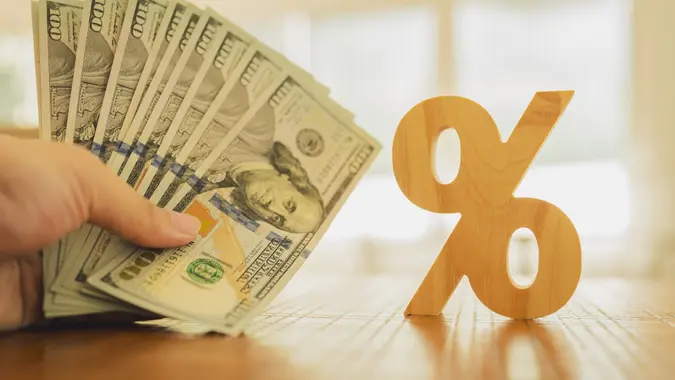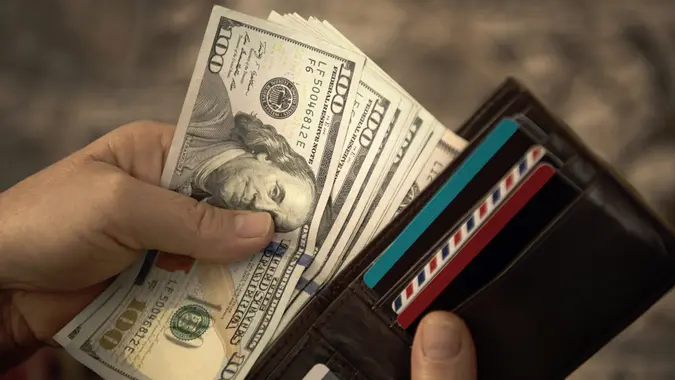Here’s the Magic Number To Keep in Your Emergency Fund To Feel Less Stressed

Commitment to Our Readers
GOBankingRates' editorial team is committed to bringing you unbiased reviews and information. We use data-driven methodologies to evaluate financial products and services - our reviews and ratings are not influenced by advertisers. You can read more about our editorial guidelines and our products and services review methodology.

20 Years
Helping You Live Richer

Reviewed
by Experts

Trusted by
Millions of Readers
Knowing how much to save in an emergency fund can feel like a guessing game, but the latest research offers a clear target. Whether you’re trying to sleep better at night or just want a little more financial peace of mind, hitting this number could help. It’s not about being perfect — it’s about being prepared. According to Vanguard research, here’s the emergency savings amount that can help reduce money-related stress.
The Importance of a Emergency Fund
At one time or another, most people have had an emergency for home repairs, unexpected medical bills, car repairs or even loss of income. But can most people afford to cover the amount of money involved in one of these emergencies? According to Forbes, more than one in four Americans (28%) have less than $1,000 saved. That includes 20% of Baby Boomers, 27% of Gen X, 31% of Millennials and 32% of Gen Z.
Living paycheck to paycheck and the rising costs of living are just a few of the things that can contribute to not being able to put money aside in savings, which could turn into a serious problem if an emergency arises.
Most people do have at least one credit card that could be used in an emergency, but then what can be done to recoup the funds that were used? If having to rely on credit cards or loans, then there is also a question of how will these be repaid? Repayment might lead to borrowing from a retirement fund if a loan needed to be repaid quickly or it could take longer if no extra funds are readily available. Credit cards have interest rates and extra fees that could be incurred if payments are not made on time. All these things could cause financial stress — stress that could be avoided by starting an emergency fund.
The Magic Number
According to Vanguard’s research, the amount to keep in an emergency fund is at least $2,000 for better financial well-being.
There is a fine line between the feeling of financial well-being that an emergency fund can give and financial stress. People that do not have an emergency fund usually spend 7.3 hours a week dealing and thinking about finances, 6.1 hours a week being distracted by financial stress at work and 51% of people are 3 times more likely to report higher financial stress year over year. This research from Vanguard highlights just how important an emergency fund is when it comes to reducing stress and handling financial setbacks.
Building an Emergency Fund
Consumer Finance suggests setting a savings habit that starts with setting a savings goal. Next, consider how much to put aside at specific intervals. Use auto drafts from a checking account to a savings account once a month or possibly put money aside each week or pay period.
Consumer Finance also has a savings planning tool that can help to calculate how long it will take to reach a goal depending on how much money and how often it can be transferred to a savings account.
If living paycheck to paycheck keeps an emergency fund from becoming a reality, managing money by tracking spending and savings can reveal adjustments where money could be saved and help prevent going over budget. Asking creditors to adjust payment due dates may help, too. When extra money is available, like a tax refund, a monetary gift or holiday bonus, try and set aside a portion of the money for the emergency fund. Another idea is to check on direct deposits to see if a portion of a paycheck could be split between a checking account and savings account.
Make sure to regularly track the progress made by either being notified automatically of the savings account balance or keeping a written account with a running total amount. This can be an encouraging way to keep being motivated to save money for the emergency fund. It’s also important to recognize when a savings habit goal has been met and try to find a small way to celebrate the progress.
More From GOBankingRates
 Written by
Written by  Edited by
Edited by 

























